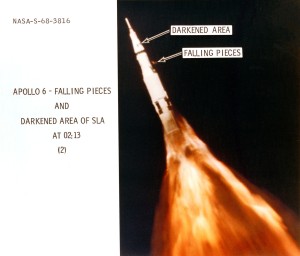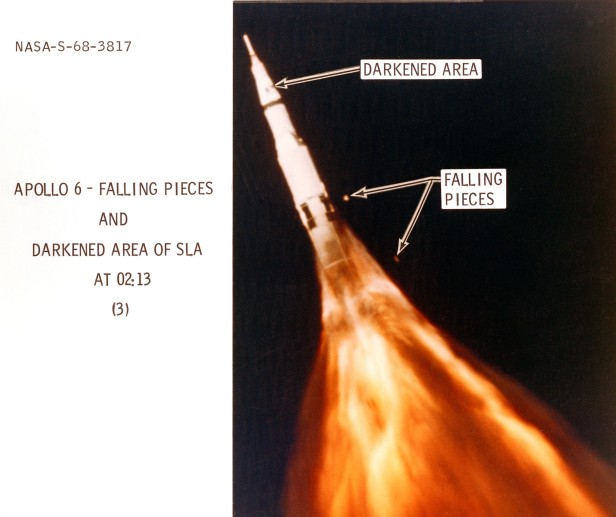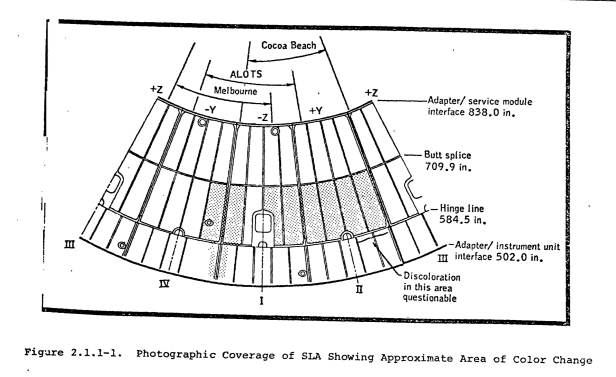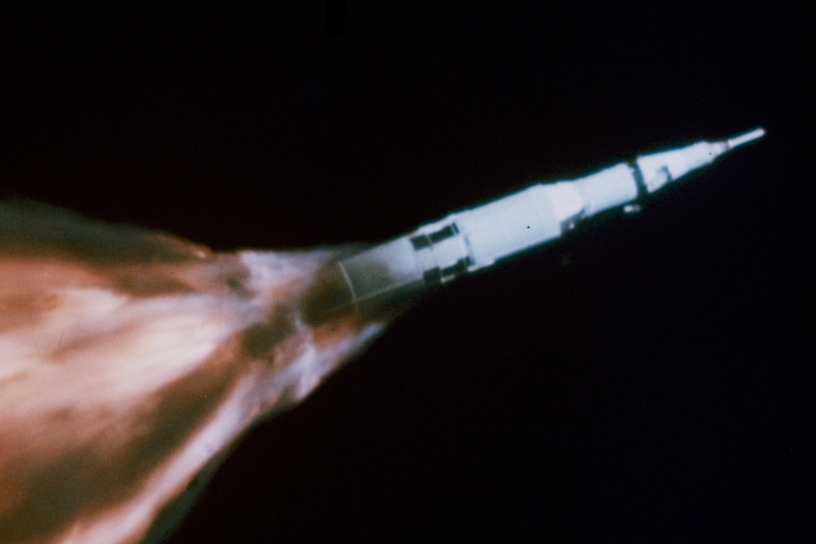Let’s take a closer look at how incredibly close Apollo 6 came to disintegration. You should get some coffee. And a blankie.
NASA’s final report on the mission is rich with detail, but let’s look at the one failure that never stops causing my mouth to drop: The failure of the Spacecraft LM Adapter, or SLA. Inside is a Lunar Module test article.
 The SLA, designed by North American Aviation, was made of nearly 2 inches of aluminum honeycomb material. Now, the Saturn V’s early design was plagued by “pogo” oscillations that threatened to shake the vehicle apart.
The SLA, designed by North American Aviation, was made of nearly 2 inches of aluminum honeycomb material. Now, the Saturn V’s early design was plagued by “pogo” oscillations that threatened to shake the vehicle apart.
Pogo oscillations shook Apollo 6 early on, as the Launch Escape System was wildly vibrating at 1 min 28 sec into the flight.
The POGO caused one of the five J-2 engines to shutdown. But a miswiring caused a second J-2 to shutdown, too, leaving the vehicle with only three engines to limp forward.
At about 2 min 13 sec, several SLA panels began to bend, inward, and eventually buckle entirely, falling from the vehicle as the photos show. Most of this damage was being caused by dynamic pressures.
 If this event occurred earlier when the atmosphere was thicker, drag forces would have certainly caused the vehicle to break apart further.
If this event occurred earlier when the atmosphere was thicker, drag forces would have certainly caused the vehicle to break apart further.
The report suggests that there were fears of corrosion damage to the SLA aluminum (the things sat around in the Florida salty sea air).
What you may not know is that, at the same time, one of the three wires that are used by the Emergency Detection System (EDS) lost power.
There are three such wires throughout the length of the Saturn. If two of them lost power, the Launch Escape System would’ve activated, pulling the Block I CSM-020 Command Module away and ending the mission.
 “Apollo 13” film fans hear Lovell say “EDS to manual, inboard” during their launch, just prior to their first staging. Basically, he’s turned off the EDS because they’re near the end of the LES’s usefulness and will jettison the LES just after staging.
“Apollo 13” film fans hear Lovell say “EDS to manual, inboard” during their launch, just prior to their first staging. Basically, he’s turned off the EDS because they’re near the end of the LES’s usefulness and will jettison the LES just after staging.

For the next mission (Apollo 7, the first manned mission) and later, some vent holes were made to check for corrosion and later for Apollo 8 to equalize any pressure differential.
Also for 8, cork paneling covered the SLA to aid in temperature variations, and a type of ultrasonic inspection was done to all future adapters to check for voids in the aluminum.
The distance between the Service Module and the SLA apparently moved at least 3 inches in flight because of the SLA damage as well.
Odds are likely that Apollo 6 would have only made the lower end of the front page at best if it had broken up on its launch date, April 4, 1968. Dr. Martin Luther King was assassinated that same day.
Read the report at your leisure. (This material may be too sensitive for younger space enthusiasts.)
Source photos by NASA, and thanks to the guys on the NASA SpaceFlight.com forums (free membership may be required to view) for the detailed analysis ones.


I didn’t know about this. I’ve had a skim through the anomaly reports, they make for interesting reading, to say the least! Amazed the whole thing didn’t turn into an impromptu cloud of aluminium…
LikeLike
If the SLA failure happened a few seconds earlier, in denser atmosphere, that cloud would’ve happened.
LikeLike
Yeah, it sounds like a very lucky escape. The oscillations on the escape tower don’t sound like much fun either…! The more I read, the more impressed I am with the Apollo 8 crew, as I would certainly be having second thoughts about manned flight after 6 nearly shook itself to bits. And I hold Jim Lovell in pretty high regard anyway!
LikeLiked by 1 person